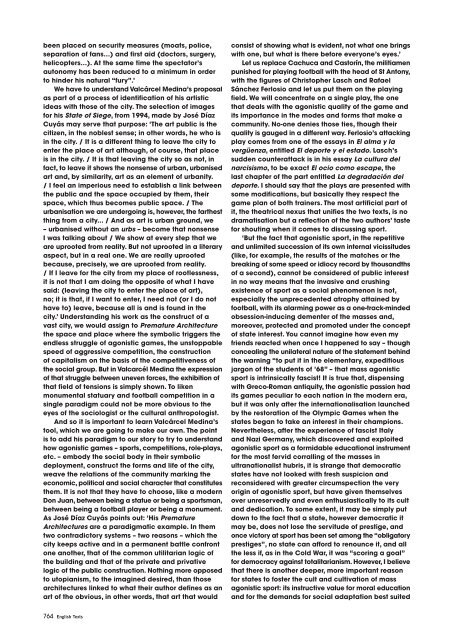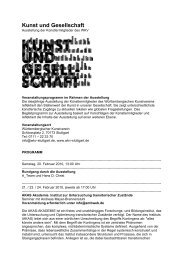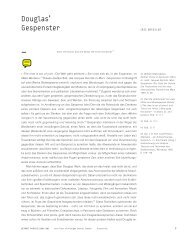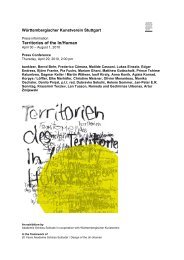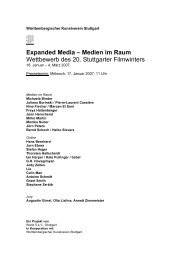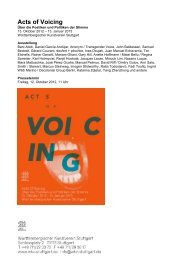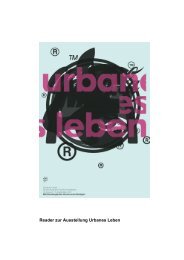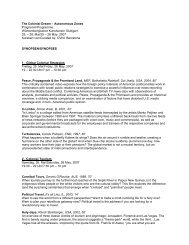English Texts
English Texts
English Texts
You also want an ePaper? Increase the reach of your titles
YUMPU automatically turns print PDFs into web optimized ePapers that Google loves.
een placed on security measures (moats, police,<br />
separation of fans…) and first aid (doctors, surgery,<br />
helicopters…). At the same time the spectator’s<br />
autonomy has been reduced to a minimum in order<br />
to hinder his natural “fury”.’<br />
We have to understand Valcárcel Medina’s proposal<br />
as part of a process of identification of his artistic<br />
ideas with those of the city. The selection of images<br />
for his State of Siege, from 1994, made by José Díaz<br />
Cuyás may serve that purpose: ‘The art public is the<br />
citizen, in the noblest sense; in other words, he who is<br />
in the city. / It is a different thing to leave the city to<br />
enter the place of art although, of course, that place<br />
is in the city. / It is that leaving the city so as not, in<br />
fact, to leave it shows the nonsense of urban, urbanised<br />
art and, by similarity, art as an element of urbanity.<br />
/ I feel an imperious need to establish a link between<br />
the public and the space occupied by them, their<br />
space, which thus becomes public space. / The<br />
urbanisation we are undergoing is, however, the farthest<br />
thing from a city... / And as art is urban ground, we<br />
– urbanised without an urbs – become that nonsense<br />
I was talking about / We show at every step that we<br />
are uprooted from reality. But not uprooted in a literary<br />
aspect, but in a real one. We are really uprooted<br />
because, precisely, we are uprooted from reality.<br />
/ If I leave for the city from my place of rootlessness,<br />
it is not that I am doing the opposite of what I have<br />
said: (leaving the city to enter the place of art),<br />
no; it is that, if I want to enter, I need not (or I do not<br />
have to) leave, because all is and is found in the<br />
city.’ Understanding his work as the construct of a<br />
vast city, we would assign to Premature Architecture<br />
the space and place where the symbolic triggers the<br />
endless struggle of agonistic games, the unstoppable<br />
speed of aggressive competition, the construction<br />
of capitalism on the basis of the competitiveness of<br />
the social group. But in Valcarcél Medina the expression<br />
of that struggle between uneven forces, the exhibition of<br />
that field of tensions is simply shown. To liken<br />
monumental statuary and football competition in a<br />
single paradigm could not be more obvious to the<br />
eyes of the sociologist or the cultural anthropologist.<br />
And so it is important to learn Valcárcel Medina’s<br />
tool, which we are going to make our own. The point<br />
is to add his paradigm to our story to try to understand<br />
how agonistic games – sports, competitions, role-plays,<br />
etc. – embody the social body in their symbolic<br />
deployment, construct the forms and life of the city,<br />
weave the relations of the community marking the<br />
economic, political and social character that constitutes<br />
them. It is not that they have to choose, like a modern<br />
Don Juan, between being a statue or being a sportsman,<br />
between being a football player or being a monument.<br />
As José Díaz Cuyás points out: ‘His Premature<br />
Architectures are a paradigmatic example. In them<br />
two contradictory systems – two reasons – which the<br />
city keeps active and in a permanent battle confront<br />
one another, that of the common utilitarian logic of<br />
the building and that of the private and privative<br />
logic of the public construction. Nothing more opposed<br />
to utopianism, to the imagined desired, than those<br />
architectures linked to what their author defines as an<br />
art of the obvious, in other words, that art that would<br />
consist of showing what is evident, not what one brings<br />
with one, but what is there before everyone’s eyes.’<br />
Let us replace Cachuca and Castorín, the militiamen<br />
punished for playing football with the head of St Antony,<br />
with the figures of Christopher Lasch and Rafael<br />
Sánchez Ferlosio and let us put them on the playing<br />
field. We will concentrate on a single play, the one<br />
that deals with the agonistic quality of the game and<br />
its importance in the modes and forms that make a<br />
community. No-one denies those ties, though their<br />
quality is gauged in a different way. Ferlosio’s attacking<br />
play comes from one of the essays in El alma y la<br />
vergüenza, entitled El deporte y el estado. Lasch’s<br />
sudden counterattack is in his essay La cultura del<br />
narcisismo, to be exact El ocio como escape, the<br />
last chapter of the part entitled La degradación del<br />
deporte. I should say that the plays are presented with<br />
some modifications, but basically they respect the<br />
game plan of both trainers. The most artificial part of<br />
it, the theatrical nexus that unifies the two texts, is no<br />
dramatisation but a reflection of the two authors’ taste<br />
for shouting when it comes to discussing sport.<br />
‘But the fact that agonistic sport, in the repetitive<br />
and unlimited succession of its own internal vicissitudes<br />
(like, for example, the results of the matches or the<br />
breaking of some speed or idiocy record by thousandths<br />
of a second), cannot be considered of public interest<br />
in no way means that the invasive and crushing<br />
existence of sport as a social phenomenon is not,<br />
especially the unprecedented atrophy attained by<br />
football, with its alarming power as a one-track-minded<br />
obsession-inducing dementer of the masses and,<br />
moreover, protected and promoted under the concept<br />
of state interest. You cannot imagine how even my<br />
friends reacted when once I happened to say – though<br />
concealing the unilateral nature of the statement behind<br />
the warning “to put it in the elementary, expeditious<br />
jargon of the students of ’68” – that mass agonistic<br />
sport is intrinsically fascist! It is true that, dispensing<br />
with Greco-Roman antiquity, the agonistic passion had<br />
its games peculiar to each nation in the modern era,<br />
but it was only after the internationalisation launched<br />
by the restoration of the Olympic Games when the<br />
states began to take an interest in their champions.<br />
Nevertheless, after the experience of fascist Italy<br />
and Nazi Germany, which discovered and exploited<br />
agonistic sport as a formidable educational instrument<br />
for the most fervid corralling of the masses in<br />
ultranationalist hubris, it is strange that democratic<br />
states have not looked with fresh suspicion and<br />
reconsidered with greater circumspection the very<br />
origin of agonistic sport, but have given themselves<br />
over unreservedly and even enthusiastically to its cult<br />
and dedication. To some extent, it may be simply put<br />
down to the fact that a state, however democratic it<br />
may be, does not lose the servitude of prestige, and<br />
once victory at sport has been set among the “obligatory<br />
prestiges”, no state can afford to renounce it, and all<br />
the less if, as in the Cold War, it was “scoring a goal”<br />
for democracy against totalitarianism. However, I believe<br />
that there is another deeper, more important reason<br />
for states to foster the cult and cultivation of mass<br />
agonistic sport: its instructive value for moral education<br />
and for the demands for social adaptation best suited<br />
764 <strong>English</strong> <strong>Texts</strong>


